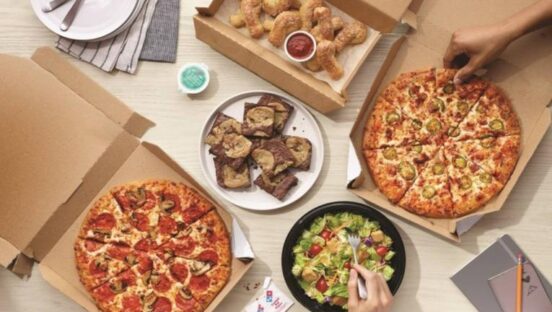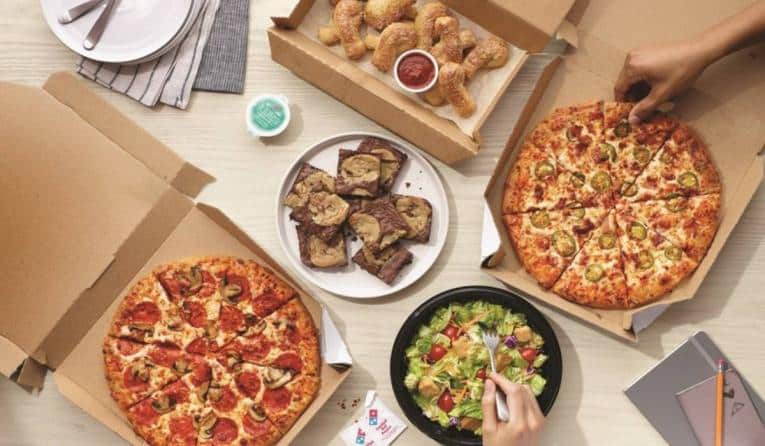Domino’s CEO Russell Weiner said the franchise system lives by the adage, “To be the best, you have to beat the best.” Even when the best may be yourself, he added.
That’s why the company is launching a “Summer of Service” training program. All U.S. franchisees will be invited to attend the event, which will be held in Ann Arbor, Michigan, the chain’s headquarters. Weiner said it will be one of the largest system training efforts in Domino’s history. The chief executive expects best practices to be shared and franchisees to leave with specific plans to positively impact each of their restaurants.
“You think of what we learned through COVID. We went through some capacity constraints. We went through driver availability issues. They say necessity is the mother of invention, and that’s why we’re doing this Summer of Service program here,” Weiner said during Domino’s Q1 earnings call. “We’re inviting our franchisees because we’ve made significant improvements in innovations. Because of all this learning, we will now be better in our circle of operations and our technology, and these are substantial enough that it’s not something we can train people in a video.”
” … At the end of the day, in order to really step-change ourselves when these macro things go away, it’s going to be stepping up service,” he added. “I think hopefully this is an example of how we’re leaning in there.”
READ MORE:
Domino’s Delivery Challenges Aren’t Ending Anytime Soon
Why Domino’s Could Be One of 2023’s Biggest Winners
Domino’s CEO: Brand is as Strong as Ever
Domino’s Evaluating ‘All Options’ as Delivery Woes Continue
Amid these efforts, delivery continues to be a concern. Domino’s has a $1 billion international business with third-party delivery aggregators, and Weiner said the company is learning from that segment every day. But not to the point he is willing to commit to forming any significant partnership in the U.S.
The company has been posed with questions around third-party delivery for years, especially recently as the channel continues to dip. In the first quarter, the concept’s delivery same-store sales dropped 2.1 percent, rolling over a 10.7 percent decline in 2022. Domino’s attributed this decrease to customers opting for dine-in occasions and guests tightening their budgets. It’s important to note, however, delivery service times improved over a minute in the first quarter and Domino’s gained market share in quick-service pizza delivery overall.
Meanwhile, carryout same-store sales rose 13.4 percent in the first quarter, on top of 11.3 percent growth in 2022. The channel accounts for half of Domino’s business. Weiner said the company is experiencing trade-down from non-Domino’s carryout to Domino’s carryout.
The brand’s U.S. comps grew 3.6 percent, rolling over a decrease of 3.6 percent last year. The increase was fueled by a rise in average ticket, thanks to 6.2 percent pricing. That was partially offset by lower order volume. Also, Domino’s benefited from lapping Omicron and the fact that it rolled out a 50 percent off promotion this quarter and not in the prior year. Those tailwinds aren’t expected to help for the rest of 2023 as Omicron comparisons dissipate and the brand rolls over 50 percent off promotions ran last year.
Instead of looking outward for assistance, the pizza chain is internally focusing on becoming a “stickier brand,” which Weiner defined as getting things right on value and service.
“There are opportunities and there are also potential issues with competing with folks or working with folks,” Weiner said. “And we’re not going to think about going into anything unless we’re out best Domino’s. And the best Domino’s, we’re getting there every day. … We’re always looking for drill sites. If there are incremental drill sites that are smart for us and [third-party delivery] is one of them, you’re never going to hear that this team closes the book on things. Right now we’re focusing on making ourselves a better Domino’s.”
To Weiner, Domino’s biggest opportunity is innovation, which touches multiple areas. First, there’s the menu. In Q1, the brand launched Loaded Tots, a side item that’s fitting nicely into the company’s Mix and Match menu. (Keep in mind, Domino’s increased the price of its Mix and Match Deal from $5.99 to $6.99 last year across delivery and carryout.) For franchisees, Loaded Tots drive healthy tickets, are largely incremental, and have a strong margin profile, Weiner said. So far, it appears the product is headed for a higher trajectory than Domino’s previous two launches, Dips and Twists and the Chicken Taco and Cheeseburger pizzas.
As for delivery innovation, Domino’s last year announced the rollout of the largest electric vehicle delivery fleet in the U.S. The initial launch called for 800 cars, but now the pizza giant is upping that to more than 1,000. Weiner noted that these vehicles are not only better for the environment, but they also offer opportunities to delivery drivers who may not have a vehicle of their own. In terms of technical innovation, in Q1 Domino’s added in-car ordering through Apple CarPlay. Customers can either “tap to order,” which lets guests submit a saved order, or “call to order,” which allows them to place an order via a customer service representative.
Looking into the future, the brand plans to refresh its loyalty program. When Domino’s rolled it out in 2015, the pizza concept was more of a delivery company, with carryout gaining momentum. As a result, the loyalty program was formatted toward delivery customers. A major goal of the update will be to explicitly cater to carryout consumers, in addition to delivery guests. Domino’s has also started a redesign of its e-commerce platform. That work will continue into 2024.
To fund these initiatives, franchisees’ technology fee will increase to 39.5 cents from 31.5 cents, effective at the start of Q2. Domino’s will balance this uptick with a 25-basis-point reduction in contributions to the national advertising fund.
“We take a holistic look at the franchisees’ P&Ls, and we just think that this is a better investment over the course of the next year,” Weiner said. “Because of where we are in our marketing budget, I don’t expect an impression decline. I just think that this was a great overall use of their money for the year.”
In Q1, Domino’s crossed 20,000 units globally, finishing at 20,008. That includes 6,708 in the U.S. and 13,300 internationally. Domestically, the brand opened a net of 22 restaurants in the quarter. Outside the U.S., a net of 106 locations debuted. Store openings are still being pressured by delays in supply chain and permitting, but Domino’s expects the headwinds to soften in the latter half of 2023. Approximate buildout costs increased 20 percent last year, but franchisees still have three-year paybacks.
Average store profitability in 2022 was $139,000. Profit was higher in Q4 2022 compared to Q4 2019 as franchisees felt the impact of Mix and Match’s price increase. Margins are projected to get better in 2023, aided by the margin flow-through of Loaded Tots.
“This proves to me, and more importantly to [franchisees], that building a Domino’s store remains one of the best investments in the restaurant industry,” Weiner said.








